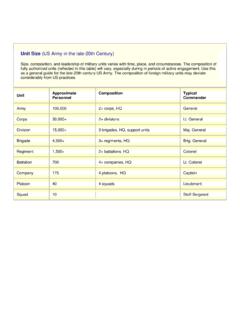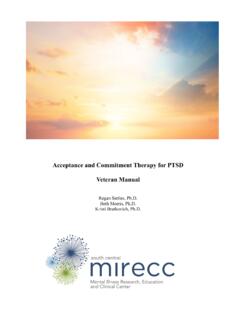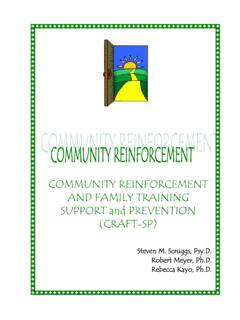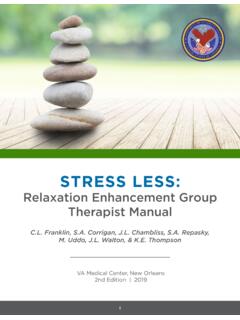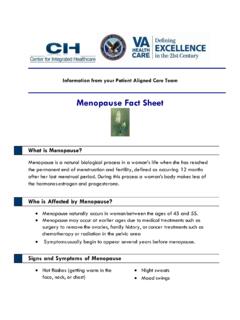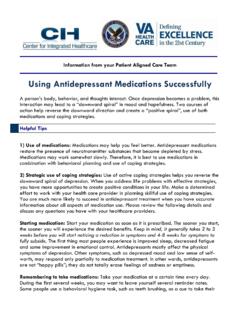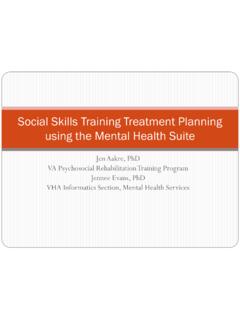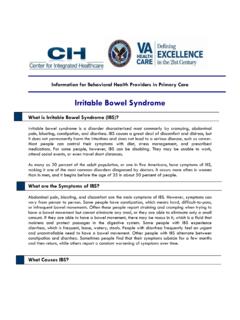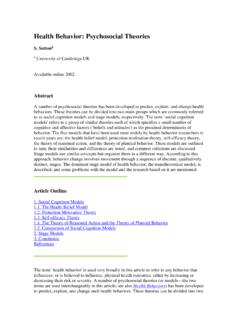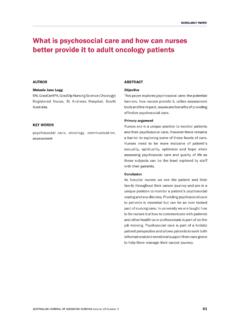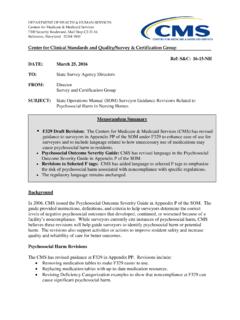Transcription of ACUTE Therapeutic Risk Management – Risk Stratification Table
1 ACUTE Therapeutic Risk Management Risk Strati cation Table HIGH ACUTE RISK Essential Features Suicidal ideation with intent to die by suicide Inability to maintain safety independent external support/help Common Warning Signs A plan for suicide Recent attempt and/or ongoing preparatory behaviors ACUTE major mental illness ( , MDD episode, ACUTE mania, ACUTE psychosis, recent/current drug relapse) Exacerbation of personality disorder ( , increased borderline symptomatology) Common Risk Factors Access to means ACUTE psychosocial stressors ( , job loss, relationship dissolution, relapse on alcohol) Action Typically requires psychiatric hospitalization to maintain safety and aggressively target modi -able factors. These individuals need to be directly observed until on a secure unit and kept in an environ-ment with limited access to lethal means ( keep away from sharps, cords/tubing, toxic substances).
2 During hospitalization co-occurring psychiatric symptoms should also be addressed. INTERMEDIATE ACUTE RISK Essential Features Suicidal ideation to die by suicide Ability to maintain safety, independent of external support/help These individuals may present similarly to those at high ACUTE risk, sharing many of the features. The only di erence may be lack of intent, based upon an identi ed reason for living ( children), and ability to abide by a safety plan and maintain their own safety. Preparatory behaviors are likely to be absent. Action Consider psychiatric hospitalization, if related factors driving risk are responsive to inpatient treatment ( ACUTE psychosis). Outpatient Management of suicidal thoughts and/or behaviors should be intensive and include: frequent contact, regular re-assessment of risk, and a well-articulated safety plan Mental health treatment should also address co-occurring psychiatric symptoms.
3 Essential Features No current suicidal intent AND No speci c and current suicidal plan AND No preparatory behaviors AND Collective high con dence ( , patient, care provider, family member) in the ability of the patient to independently maintain safety Individuals may have suicidal ideation, but it will be with little or no intent or speci c current plan. If a plan is present, the plan is general and/or vague, and without any associated preparatory behaviors ( , I d shoot myself if things got bad enough, but I don t have a gun ). These patients will be capable of engaging appropriate coping strategies, and willing and able to utilize a safety plan in a crisis situation. Action Can be managed in primary care. Outpatient mental health treatment may also be indicated, particularly if suicidal ideation and psychiatric symptoms are co-occurring.
4 LOW ACUTE RISK *Overall level of individual risk may be increased or decreased based upon warning signs, risk factors and protective factors CHRONIC Therapeutic Risk Management Risk Strati cation Table HIGH CHRONIC RISK Essential Features Common Warning Sign Chronic suicidal ideation Common Risk Factors Chronic major mental illness and/or personality disorder History of prior suicide attempt(s) History of substance abuse/dependence Chronic pain Chronic medical condition Limited coping skills Unstable or turbulent psychosocial status ( unstable housing, erratic relationships, marginal employment) Limited ability to identify reasons for living INTERMEDIATE CHRONIC RISK Essential Features These individuals may feature similar chronicity as those at high chronic risk with respect to psychiatric, substance abuse, medical and painful conditions.
5 Protective factors, coping skills, reasons for living, and relative psychosocial stability suggest enhanced ability to endure future crisis without resorting to self-directed violence. LOW CHRONIC RISK Essential Features These individuals may range from persons with no or little in the way of mental health or substance abuse problems, to persons with signi cant mental illness that is associated with relatively abundant strengths/resources. Stressors historically have typically been endured absent suicidal ideation. The following factors will generally be missing history of self-directed violence chronic suicidal ideation tendency towards being highly impulsive risky behaviors marginal psychosocial functioning Action These individuals are considered to be at chronic risk for becoming acutely suicidal, often in the context of unpredictable situational contingen-cies ( , job loss, loss of relationships, and relapse on drugs).
6 These individuals typically require: routine mental health follow-up a well-articulated safety plan, including means safety ( , no access to guns, limited medication supply) routine suicide risk screening coping skills building Management of co-occurring psychiatric symptoms Action These individuals typically require: routine mental health care to optimize psychiatric condition and maintain/enhance coping skills and protective factors. a well articulated safety plan, including means safety ( , no access to guns, limited medication supply) Management of co-occurring psychiatric symptoms Action Appropriate for mental health care on an as needed basis, some may be managed in primary care settings. Others may require mental health follow-up to continue successful treatments.
